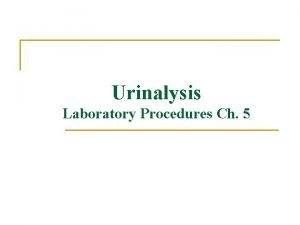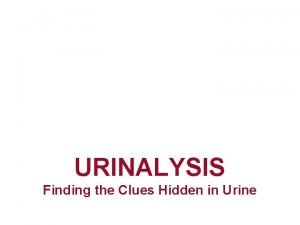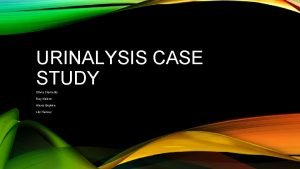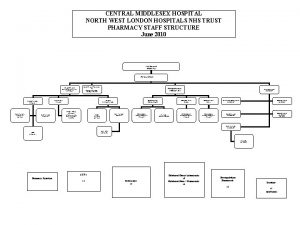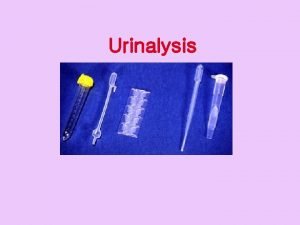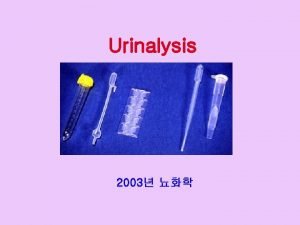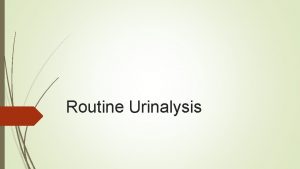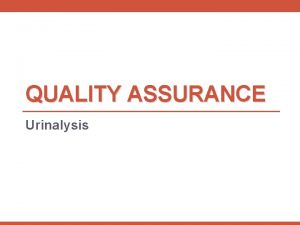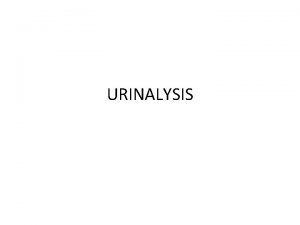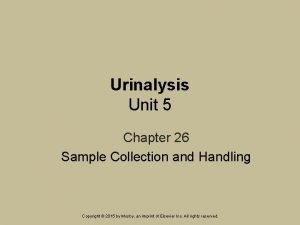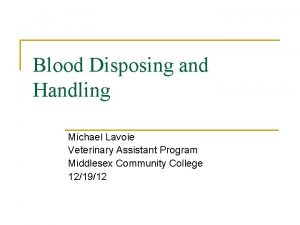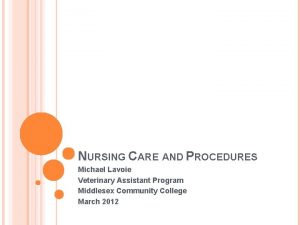Urinalysis Collection and Interpretation Michael Lavoie Middlesex Community

































- Slides: 33

Urinalysis Collection and Interpretation Michael Lavoie Middlesex Community College Veterinary Assistant Program 5/21/12

Introduction n n Urinalysis is an important tool in disease detection, as well as monitoring and screening animal health. Complete urinalysis involves both macroscopic and microscopic assessment.

The Dipstick Test n n n This is typically performed by gross visual assessment of the urine, microscopic examination, and chemical evaluation. Several chemical parameters can be measured using a commercially available in house dipstick test. This test is relatively inexpensive, and takes less than 5 minutes to complete.

Urine Testing n n Typical dipstick strips include the following tests: bilirubin, blood, glucose, ketones, p. H, protein specific gravity, and urobilinogen. Some dipsticks also include leukocytes and nitrite analyses.

Why Urine Test? n Abnormalities can be indicative of diseases of the urinary system as well as other organ systems, including liver function, acidbase status, and carbohydrate metabolism.

Sample Collection n n Urine should be collected in a clean, dry container that is free of any disinfecting or cleaning chemicals. Samples may be collected by free catch of voided sample, manual bladder expression, catheterization, or cystocentesis

Voided Samples n n Voided samples are the easiest and least invasive samples to collect However, voided samples may have contaminants that include bacteria, epithelial cells, and white blood cells.

Tips n n n Red blood cells should not be found in normal voided samples. Voided samples should be collected midstream to lessen contaminants from the vagina or prepuce Collection of samples from surfaces such as floors, cages, and litter boxes should be avoided, since these will introduce environmental contaminants.

What you need to collect a voided sample? n n n Sterile collection cup Rubber glove syringe

Manual Expression of the Bladder n n In this method, the patient’s bladder is gently squeezed until urine is expressed This technique may lead to bladder trauma resulting in hematuria, and in some instances (such as urethral obstruction) may result in a ruptured bladder

Catherization n n Catheterization is performed by placing a small hollow tube into the urethra to the level of the bladder. Urine is then withdrawn from the bladder using a syringe. Catheterized samples have less contamination from the distal urogenital tract; however, contamination from the urethra may still occur. Poor catheterization technique may lead to trauma or, less commonly, infection.

Cystocentesis n n n Cystocentesis samples are collected by inserting a sterile needle through the body wall into the bladder. Urine is withdrawn from the bladder using a syringe. A lateral or ventral approach to the bladder may be made without causing severe trauma to any vital region of the bladder.

Cystocentesis n n n Clipping or surgical preparation of the area along the body wall is not necessary prior to sample collection. Often a 1 inch or 1. 5 inch 22 gauge needle is used attached to a 6 or 12 cc syringe. The bladder is manually immobilized and the needle is inserted through the abdominal wall into the bladder, and the urine is withdrawn.

Cystocentesis n n It is important to stop aspirating prior to withdrawing the needle as this may lead to aspiration of blood cells or epithelium from the bladder wall. Animals often tolerate cystocentesis very well and little restraint is needed.

Sample Handling n n In order to obtain accurate results, the urine collection, storage and handling must be sterile and follow standard procedures. The dipstick analysis should be performed as soon after collection as possible (ideally within 30 minutes of collection) and the sample should be well mixed prior to testing.

Sample Handling n n If for some reason the test cannot be performed immediately, the sample may be covered and refrigerated. It should be allowed to return to room temperature prior to testing.

Testing Methods n n n Dipsticks may be removed from the air tight, light sealed containers. It is important not to touch the reagent areas of the strip as this may alter test results. Each reagent area should be immersed in urine by dipping.

Testing Methods n n The excess urine should be removed to prevent dilution of reagents or mixing of reagents between pads. This can be achieved by tilting the strip and allowing the urine to run off the edges

Testing Methods n n The reagent pads should be read at the specified times. These times are different for each test and also vary between dipstick manufacturers. Compare the blocks to the corresponding color chart provided by the test strip's manufacturer.

Testing Methods n n n Urine discoloration may create difficulty in visually interpreting the test results. Color changes may be masked, or read as false positive test results. If the urine is noticeably discolored, the sample may be centrifuged and the supernatant used for analysis.

Interpretation on test results n Dipsticks commonly include tests for specific gravity, p. H, glucose, protein, blood, bilirubin, ketones, urobilinogen, nitrite, and leukocytes.

Specific Gravity n n n Urine specific gravity is based on the ratio of weight of urine to weight of an equivalent volume of pure water. Although dipstick strips do have a method of approximating specific gravity, this measurement is best made with a refractometer. Normal specific gravity in dog or cat is: 1. 015 -1. 040

Urine p. H n n n This number is a reading of how acidic or alkaline the urine is. On a p. H scale of 1 -14, 7 is considered neutral, meaning neither acid nor alkaline. A number less than 7 indicates acidity, while a number greater than 7 indicates alkalinity. Normal p. H is 5. 5 -7. 0

Protein n Healthy animals will usually not have any protein in their urine, although in some cases small, trace amounts may be normal. The significance of any protein in the urine is dependent upon the specific gravity of the sample. Small amounts of protein are more significant in dilute or unconcentrated urine.

Glucose n n If the glucose (sugar) in the blood is significantly higher than normal, (for example, in diabetes) some of the excess will be found in the urine. Normal dog and cat urine should be negative for glucose on a dipstick.

Ketones n n Ketones are substances formed in the body during the breakdown of lipids (fat). When excess amounts of ketones are formed, their level rises in the blood, and in turn, the urine. The condition of excess ketones in the urine is termed "ketonuria. " Normal pet urine should have no Ketones.

Bilirubin n n Bilirubin is a pigment made by the liver from dead or dying red blood cells. Small amounts of bilirubin may sometimes be found in the urine of healthy dogs. Bilirubin in the urine of a cat is a concern and calls for further investigation. Can signify liver disease, a bile duct blockage, or hemolysis

Urobilinogen n This is a compound formed from bilirubin by intestinal bacteria. Normal cats and dogs have small amounts of urobilinogen in their urine. This is a common test that is included on many dipsticks, but the results are not considered very accurate in pets, and are difficult to interpret.

Blood n n Healthy pets may have a few red blood cells in their urine, but greater than normal amounts indicate a problem. Blood in the urine (hematuria) can be due to a number of causes, including trauma, urinary tract infection, bladder stones, and blood clotting problems.

Nitrites n n Nitrites may be produced by the bacteria present in some infections. However, this test often shows false negative results, and is considered inaccurate in pets.

White Blood Cells n n Urine sediment should be examined for the presence of white blood cells. Larger than normal numbers of white blood cells may indicate inflammation from a bladder or kidney infection. Bladder stones can also cause inflammation. However, white blood cells can also enter the urine from the prepuce or vagina during sample collection.

Bacteria n n n Urine sediment should be examined for the presence of bacteria. Small amounts of bacteria in a urine sample may be from contamination during sample collection. Large amounts of bacteria usually indicate a bladder infection, especially if an uncontaminated sample was obtained via cystocentesis.

QUESTIONS?
 Urinalysis result interpretation chart
Urinalysis result interpretation chart Lewis lavoie
Lewis lavoie Jde lavoie
Jde lavoie Tammie lavoie
Tammie lavoie How does interpretation b differ from interpretation a
How does interpretation b differ from interpretation a Chemstix urinalysis data sheet answers
Chemstix urinalysis data sheet answers Urinalysis program coordinator
Urinalysis program coordinator Coarse granular cast in urine
Coarse granular cast in urine Context clues of urinalysis
Context clues of urinalysis Urinalysis sediment
Urinalysis sediment Treatments for acute renal failure
Treatments for acute renal failure Urinalysis lab
Urinalysis lab Urinalysis case study
Urinalysis case study Pneodynamics
Pneodynamics Pyuria leukocytes urine
Pyuria leukocytes urine Why urinalysis is done
Why urinalysis is done Normal urine specific gravity
Normal urine specific gravity Domestic short-haired cat
Domestic short-haired cat Uxbridge
Uxbridge Middlesex county dental society
Middlesex county dental society North middlesex hospital pharmacy
North middlesex hospital pharmacy Middlesex county virginia
Middlesex county virginia Melissa luis middlesex county college
Melissa luis middlesex county college Middlesex college uwo
Middlesex college uwo Mdx crowdfund
Mdx crowdfund Landsat collection 1 vs collection 2
Landsat collection 1 vs collection 2 Documentary collection definition
Documentary collection definition Community action cycle for community mobilization
Community action cycle for community mobilization What do you see in this picture
What do you see in this picture Risb test slideshare
Risb test slideshare Evolution of computer architecture
Evolution of computer architecture Statutory interpretation advantages and disadvantages
Statutory interpretation advantages and disadvantages Construction and interpretation of relief profile
Construction and interpretation of relief profile Kmo and bartlett's test interpretation
Kmo and bartlett's test interpretation







